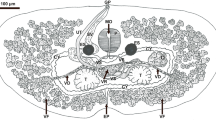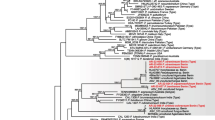Abstract
Myxosporean infections can cause severe damage to commercially grown tilapia. Here, we report a novel myxosporean that was found in gills of Oreochromis aureus male × Oreochromis niloticus female, which is an important aquaculture tilapia hybrid in Israel. Three-month-old fish were found to have cysts located in gill muscle tissue, which were filled with both immature and mature spores. Affected fish displayed higher mortality rate. Spore dimensions (10.8 ± 0.7 μm length × 6.8 ± 0.6 μm width) and molecular characterization using 18S ribosomal DNA revealed that the unknown parasite belongs in the Myxobolus clade. Based on the infection site, spore morphology and molecular characterization, we describe this parasite as Myxobolus bejeranoi n. sp. (MF401455). Phylogenetic analysis showed that the new species is most closely related to two Myxobolus spp. from O. niloticus in Egypt and Ghana.


Similar content being viewed by others
References
Abdel-Baki A-AS, Abdel-Haleem HM, Sakran T, Zayed E, Ibrahim KE, Al-Quraishy S (2015) Two Myxobolus spp. infecting the kidney of Nile tilapia (Oreochromis Niloticus) in the River Nile at Beni-Suef governorate, Egypt, and the associated renal changes. Parasitol Res 114(3):1107–1112
Abdel-Gaber R, Abdel-Ghaffar F, Maher S, El-Mallah A-M, Al Quraishy S, Mehlhorn H (2017) Morphological re-description and phylogenetic relationship of five myxosporean species of the family Myxobolidae infecting Nile tilapia. Dis Aquat Org 124(3):201–214
Abdel-Ghaffar F, el-Toukhy A, al-Quraishy S, al-Rasheid K, Abdel-Baki AS, Hegazy A, Bashtar AR (2008) Five new myxosporean species (Myxozoa: Myxosporea) infecting the Nile tilapia Oreochromis niloticus in Bahr Shebin, Nile Tributary, Nile Delta, Egypt. Parasitol Res 103(5):1197–1205. https://doi.org/10.1007/s00436-008-1116-z
Abdel-Ghaffar F, Morsy K, el-Ganainy S, Ahmed M, Gamal S, Bashtar AR, al-Quraishy S, Mehlhorn H (2015) Twelve myxosporean species of the family Myxobolidae infecting freshwater fishes of the River Nile, Egypt, with the description of four novel species. Parasitol Res 114(8):2985–2998. https://doi.org/10.1007/s00436-015-4501-4
Abdelkhalek NK, El-Adl MA, Ali M, Hamed MF (2016) Direct submission. NCBI KU297653
Awal MA, Begum AA, Chandra KJ, Ahmed GU, Kurohmaru M (2001) Myxosporidian infection of gills and skin among carp from nursery ponds in Bangladesh: histopathology. Vet Arh 71(5):265–276
Barta JR, Martin DS, Liberator PA, Dashkevicz M, Anderson JW, Feighner SD, Elbrecht A, Perkins-Barrow A, Jenkins MC, Danforth HD, Ruff MD, Profous-Juchelka H (1997) Phylogenetic relationships among eight Eimeria species infecting domestic fowl inferred using complete small subunit ribosomal DNA sequences. J Parasitol 83(2):262–271. https://doi.org/10.2307/3284453
Ben-David J, Atkinson SD, Pollak Y, Yossifon G, Shavit U, Bartholomew JL, Lotan T (2016) Myxozoan polar tubules display structural and functional variation. Parasit Vectors 9(1):549. https://doi.org/10.1186/s13071-016-1819-4
Ben-Tuvia A (1981) Man-induced changes in the freshwater fish fauna of Israel. Aquac Res 12(4):139–148. https://doi.org/10.1111/j.1365-2109.1981.tb00023.x
Bradford MJ, Lovy J, Patterson DA, Speare DJ, Bennett WR, Stobbart AR, Tovey CP (2010) Parvicapsula minibicornis infections in gill and kidney and the premature mortality of adult sockeye salmon (Oncorhynchus nerka) from Cultus Lake, British Columbia. Can J Fish Aquat Sci 67(4):673–683. https://doi.org/10.1139/F10-017
Cai W-q, Li S-f, Ma J-y (2004) Diseases resistance of Nile tilapia (Oreochromis niloticus), blue tilapia (Oreochromis aureus) and their hybrid (female Nile tilapia× male blue tilapia) to Aeromonas sobria. Aquaculture 229(1):79–87
Camus AC, Griffin MJ (2010) Molecular characterization and histopathology of Myxobolus koi infecting the gills of a koi, Cyprinus carpio, with an amended morphological description of the agent. J Parasitol 96(1):116–124. https://doi.org/10.1645/GE-2113.1
Castresana J (2000) Selection of conserved blocks from multiple alignments for their use in phylogenetic analysis. Mol Biol Evol 17(4):540–552. https://doi.org/10.1093/oxfordjournals.molbev.a026334
Cnaani A, Tinman S, Avidar Y, Ron M, Hulata G (2004) Comparative study of biochemical parameters in response to stress in Oreochromis aureus, O. mossambicus and two strains of O. niloticus. Aquac Res 35(15):1434–1440. https://doi.org/10.1111/j.1365-2109.2004.01167.x
Diamanka A, Faye N, Fall M, Toguebaye BS (2007) Myxosporidian parasites of the genus Myxobolus butschli, 1882 found for the first time in cichlid fishes from Senegal River (West Africa). Acta Protozool 46(3):257
Dumont HJ (2009) A description of the Nile Basin, and a synopsis of its history, ecology, biogeography, hydrology, and natural resources. The Nile:1–21
Dyková I, Lom J (1978) Histopathological changes in fish gills infected with myxosporidian parasites of the genus Henneguya. J Fish Biol 12(3):197–202. https://doi.org/10.1111/j.1095-8649.1978.tb04165.x
Eiras J, Molnár K, Lu Y (2005) Synopsis of the species of Myxobolus Bütschli, 1882 (Myxozoa: Myxosporea: Myxobolidae). Syst Parasitol 61(1):1–46
Eiras JC, Zhang J, Molnár K (2014) Synopsis of the species of Myxobolus Bütschli, 1882 (Myxozoa: Myxosporea, Myxobolidae) described between 2005 and 2013. Syst Parasitol 88(1):11–36. https://doi.org/10.1007/s11230-014-9484-5
El-Hawarry WN, Saad T (2011) Effects of hybridization between Nile tilapia (Oreochromis niloticus) and blue tilapia (Oreochromis aureus) on immune response to Aeromonas hydrophila. EJAR 37(4):365–369
ElKamel A, Saleh R, Eissa I, Arafa M, Soliman H (2015) Direct submission. NCBI KP990668
Eszterbauer E (2004) Genetic relationship among gill-infecting Myxobolus species (Myxosporea) of cyprinids: molecular evidence of importance of tissue-specificity. Dis Aquat Org 58(1):35–40. https://doi.org/10.3354/dao058035
Fall M, Fomena A, Kostoingue B, Diebakate C, Faye N, Toguebaye B (2000) Myxosporidian (Myxozoa, Myxosporea) parasites of cichlid fishes from Cameroon, Senegal and Chad with a description of two new species. Ann Sci Nat Zool Biol Anim 21. Elsevier, p 81–92
Fiala I (2006) The phylogeny of Myxosporea (Myxozoa) based on small subunit ribosomal RNA gene analysis. Int J Parasitol 36(14):1521–1534. https://doi.org/10.1016/j.ijpara.2006.06.016
Fomena A, Bouix G (1997) Myxosporea (protozoa: Myxozoa) of freshwater fishes in Africa: keys to genera and species. Syst Parasitol 37(3):161
Fomena A, Marques A, Bouix G (1993) Myxosporidea (Myxozoa) of Oreochromis Niloticus (Linnaeus 1757) (teleost Cichlidae) in fish-farming pools at Melen (Yaounde, Cameroon, Central Africa). J Afr Zool 107:45–56
Goren M, Ortal R (1999) Biogeography, diversity and conservation of the inland water fish communities in Israel. Biol Conserv 89(1):1–9. https://doi.org/10.1016/S0006-3207(98)00127-X
Gouy M, Guindon S, Gascuel O (2009) SeaView version 4: a multiplatform graphical user interface for sequence alignment and phylogenetic tree building. Mol Biol Evol 27(2):221–224. https://doi.org/10.1093/molbev/msp259
Hulata G (ed) 2014) Tilapias-biology and culture. Ma’arechet Publishing House, Israel
Kalavati C, Narasimhamurti C (1985) Histopathological changes in the gills of Channa punctatus BL. Infected with Henneguya waltairensis. Arch Protistenkd 129(1–4):199–202. https://doi.org/10.1016/S0003-9365(85)80023-3
Katoh K, Standley DM (2013) MAFFT multiple sequence alignment software version 7: improvements in performance and usability. Mol Biol Evol 30(4):772–780. https://doi.org/10.1093/molbev/mst010
Kodádková A, Dyková I, Tyml T, Ditrich O, Fiala I (2014) Myxozoa in high Arctic: survey on the central part of Svalbard archipelago. Int J Parasitol: Parasites Wildlife 3(1):41–56. https://doi.org/10.1016/j.ijppaw.2014.02.001
Landsberg JH (1985) Myxosporean infections in cultured tilapias in Israel. J Protozool 32(1):194–201. https://doi.org/10.1111/j.1550-7408.1985.tb03038.x
Lee B, Hulata G, Kocher T (2004) Two unlinked loci controlling the sex of blue tilapia (Oreochromis aureus). Heredity (Edinb) 92(6):543–549. https://doi.org/10.1038/sj.hdy.6800453
Lom J, Arthur J (1989) A guideline for the preparation of species descriptions in Myxosporea. J Fish Dis 12(2):151–156. https://doi.org/10.1111/j.1365-2761.1989.tb00287.x
Molnár K (1994) Comments on the host, organ and tissue specificity of fish myxosporeans and on the types of their intrapiscine development. Parasitol Hung 27:5–20
Molnár K, Eszterbauer E (2015) Specificity of infection sites in vertebrate hosts. In: Okamura B, Gruhl A, Bartholomew JL (eds) Myxozoan evolution, ecology and development. Springer international publishing, Cham, pp 295–313. https://doi.org/10.1007/978-3-319-14753-6_16
Nchoutpouen E, Lekeufack Folrfack GB, Fomena A (2011) Structure and population dynamics of Myxobolus infections in wild and cultured Oreochromis Niloticus Linnaeus, 1758 in the noun division (West-Cameroon). J Cell Anim Biol 5(12):254–264
Pruginin Y, Rothbard S, Wohlfarth G, Halevy A, Moav R, Hulata G (1975) All-male broods of Tilapia nilotica × T. aurea hybrids. Aquaculture 6(1):11–21. https://doi.org/10.1016/0044-8486(75)90086-1
Rijn J, Shilo M (1989) Environmental factors in fish culture systems. CRC Press Inc., Boca Raton, pp 163–177
Romana-Eguia MRR, Ikeda M, Basiao ZU, Taniguchi N (2004) Genetic diversity in farmed Asian Nile and red hybrid tilapia stocks evaluated from microsatellite and mitochondrial DNA analysis. Aquaculture 236(1):131–150. https://doi.org/10.1016/j.aquaculture.2004.01.026
Siddall ME, Martin DS, Bridge D, Desser SS, Cone DK (1995) The demise of a phylum of protists: phylogeny of myxozoa and other parasitic cnidaria. J Parasitol 81(6):961–967. https://doi.org/10.2307/3284049
Soliman H, Saleh R, Eissa I, Arafa M, ElKamel A (2015) Direct submission. NCBI KP990670
Verner-Jeffreys D, et al. (2018) Streptococcus agalactiae Multilocus sequence type 261 is associated with mortalities in the emerging Ghanaian tilapia industry. J Fish Dis 41(175–179)
Wohlfarth G, Hulata G, Halevy A (1990) Growth, survival and sex ratio of some tilapia species and interspecific hybrids. Eur Aquacult Soc Spec Publ 11:87–101
Author information
Authors and Affiliations
Corresponding author
Ethics declarations
Ethical approval
All applicable international, national, and/or institutional guidelines for the care and use of animals were followed.
Conflict of interest
The authors declare that they have no conflict of interest.
Additional information
Section Editor: Christopher Whipps
Rights and permissions
About this article
Cite this article
Lövy, A., Smirnov, M., Brekhman, V. et al. Morphological and molecular characterization of a novel myxosporean parasite Myxobolus bejeranoi n. sp. (Cnidaria: Myxosporea) from hybrid tilapia in Israel. Parasitol Res 117, 491–499 (2018). https://doi.org/10.1007/s00436-017-5725-2
Received:
Accepted:
Published:
Issue Date:
DOI: https://doi.org/10.1007/s00436-017-5725-2




